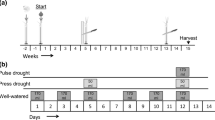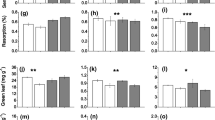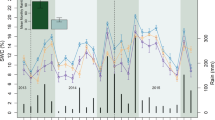Abstract
Climate change will increase the frequency of droughts over the next century, with severe consequences for ecosystem function in semi-arid grasslands. The shortgrass steppe (SGS) experiences some of the largest interannual variation in precipitation among terrestrial biomes and exhibits extremely high sensitivity to drought. Yet despite decades of research describing the consequences of drought for ecosystem function in the SGS, we currently have little information regarding the impact of drought on bioavailability of important nutrients other than nitrogen, the contribution of herbivores to bioavailable concentrations of these nutrients, and whether drought alters herbivore-derived nutrient cycling. To quantify the impacts of long-term drought and small-bodied herbivores on nutrient cycling and aboveground net primary production (ANPP), we factorially manipulated rainfall and herbivore presence in the SGS of northern Colorado. Specifically, we measured the impacts of drought and herbivores on bioavailability of ten important nutrients: aluminum, calcium, iron, potassium, magnesium, manganese, nitrate, phosphorus, sulfur, and zinc. We then correlated these nutrients with grass production to determine whether reduced plant growth under drought conditions causes a belowground buildup of nutrients. Drought reduced ANPP as expected, and also altered concentrations of many nutrients apart from N, which clustered in their drought response. In contrast, small-bodied herbivores did not affect ANPP or soil N. However, they did contribute to the bioavailable soil concentrations of two important nutrients: PO4-P and S. Importantly, drought generally did not modify the contribution of herbivores to nutrient cycling, suggesting that herbivores might be a critical component of biogeochemical cycling regardless of precipitation in semi-arid grasslands.



Similar content being viewed by others
References
Augé RM (2001) Water relations, drought and vesicular-arbuscular mycorrhizal symbiosis. Mycorrhiza 11:3–42
Avolio ML, Smith MS (2013) Mechanisms of selection: phenotypic differences among genotypes explain patterns of selection in dominant species. Ecology 94:953–965
Bakker ES, Ritchie ME, Olff H, Milchunas DG, Knops JMH (2006) Herbivore impact on grassland plant diversity depends on habitat productivity and herbivore size. Ecol Lett 9:780–788
Bakker ES, Knops JMH, Milchunas DG, Ritchie ME, Olff H (2009) Cross-site comparison of herbivore impact on nitrogen availability in grasslands: the role of plant nitrogen concentration. Oikos 118:1613–1622
Balakrishnan K, Rajendran C, Kulandaivelu G (2000) Differential responses of iron, magnesium, and zinc deficiency on pigment composition, nutrient content, and photosynthetic activity in tropical fruit crops. Photosynthetica 38:477–479
Belovsky GE, Slade JB (1995) Dynamics of two Montana grasshopper populations: relationships among weather, food abundance and intraspecific competition. Oecologia 101:383–396
Belovsky GE, Slade JB (2000) Insect herbivory accelerates nutrient cycling and increases plant production. Proc Natl Acad Sci USA 97:14412–14417
Brady MJ, Slade NA (2004) Long-term dynamics of a grassland rodent community. J Mammal 85:552–561
Branson DH, Joern A, Sword GA (2006) Sustainable management of insect herbivores in grassland ecosystems: new perspectives in grasshopper control. Bioscience 56:743
Burkepile DE, Allgeier JE, Shantz AA, Pritchard CE, Lemoine NP, Bhatti LH, Layman CA (2013) Nutrient supply from fishes facilitates macroalgae and suppresses corals in a Caribbean coral reef ecosystem. Sci Rep 3:1493
Button KS, Ioannidis JPA, Mokrysz C, Nosek BA, Flint J, Robinson ESJ, Munafò MR (2013) Power failure: why small sample size undermines the reliability of neuroscience. Nat Rev Neurosci 14:365–376
Cakmak I (2005) The role of potassium in alleviating detrimental effects of abiotic stresses in plants. J Plant Nutr Soil Sci 168:521–530
Capinera JL, Horton DR (1989) Geographic variation in effects of weather on grasshopper infestation. Environ Entomol 18:8–14
Capinera JL, Thompson DC (1987) Dynamics and structure of grasshopper assemblages in shortgrass prairie. Can Entomol 119:567–575
Craig DP, Bock CE, Bennett BC, Bock JH (1999) Habitat relationships among grasshoppers (Orthoptera: Acrididae) at the western limit of the Great Plains in Colorado. Am Midl Nat 142:314–327
Egilla JN, Davies FT, Boutton TW (2005) Drought stress influences leaf water content, photosynthesis, and water-use efficiency of Hibiscus rosa-sinensis at three potassium concentrations. Photosynthetica 43:135–140
Evans SE, Burke IC (2013) Carbon and nitrogen decoupling under an 11-year drought in the shortgrass steppe. Ecosystems 16:20–33
Fay PA, Prober SM, Harpole WS, Knops JMH, Bakker JD, Borer ET, Lind EM, MacDougall AS, Seabloom EW, Wragg PD, Adler PB, Blumenthal DM, Buckley YM, Chu C, Cleland EE, Collins SL, Davies KF, Du G, Feng X, Firn J, Gruner DS, Hagenah N, Hautier Y, Heckman RW, Jin VL, Kirkman KP, Klein J, Ladwig LM, Li Q, McCulley RL, Melbourne BA, Mitchell CE, Moore JL, Morgan JW, Risch AC, Schütz M, Stevens CJ, Wedin DA, Yang LH (2015) Grassland productivity limited by multiple nutrients. Nat Plants 1:1–5
Fonte SJ, Schowalter TD (2005) The influence of a neotropical herbivore (Lamponius portoricensis) on nutrient cycling and soil processes. Oecologia 146:423–431
Frost CJ, Hunter MD (2004) Insect canopy herbivory and frass deposition affect soil nutrient dynamics and export in oak mesocosms. Ecology 85:3335–3347
Garsd A, Howard WE (1981) A 19-year study of microtine population fluctuations using time-series analysis. Ecology 62:930–937
Gelman A, Carlin JB (2014) Beyond power calculations: assessing Type S (Sign) and Type M (Magnitude) errors. Perspect Psychol Sci 9:641–651
Grant WE, Birney EC, French NR, Swift DM (1982) Structure and productivity of grassland small mammal communities related to grazing-induced changes in vegetative cover. J Mammal 63:248–260
Huxman TE, Smith MD, Fay PA, Knapp AK, Shaw MR, Loik ME, Smith SD, Tissue DT, Zak JC, Weltzin JF, Pockman WT, Sala OE, Haddad BM, Harte J, Koch GW, Schwinning S, Small EE, Williams DG (2004a) Convergence across biomes to a common rain-use efficiency. Nature 429:651–654
Huxman TE, Snyder KA, Tissue D, Leffler AJ, Ogle K, Pockman WT, Sandquist DR, Potts DL, Schwinning S (2004b) Precipitation pulses and carbon fluxes in semiarid and arid ecosystems. Oecologia 141:254–268
IPCC (2014) Summary for policymakers. In: Field CB, Barros V, Stocker TF, Qin D, Dokken DJ, Ebi KL, Mastrandrea MD, Mach KJ, Plattner G-K, Allen SK, Tignor M, Midgley PM (eds) Managing the risks of extreme events and disasters to advance climate change adaptation A species report of working groups I and II of the Intergovernmental Panel on Climate Change. Cambridge University Press, Cambridge, pp 1–19
Irisarri JGN, Derner JD, Porensky LM, Augustine DJ, Reeves JL, Mueller KE (2016) Grazing intensity differentially regulates ANPP response to precipitation in North American semiarid grasslands. Ecol Appl 26:1370–1380
Jiang Y, Huang B (2001) Effects of calcium on antioxidant activities and water relations associated with heat tolerance in two cool-season grasses. J Exp Bot 52:341–349
Joern A, Provin T, Behmer ST (2012) Not just the usual suspects: insect herbivore populations and communities are associated with multiple plant nutrients. Ecology 93:1002–1015
Jones E, Oliphant TE, Peterson P, et al (2001) SciPy: open source scientific tools for Python. www.scipy.org
Knapp AK, Carroll CJW, Denton EM, La Pierre KJ, Collins SL, Smith MD (2015a) Differential sensitivity to regional-scale drought in six central US grasslands. Oecologia 177:949–957
Knapp AK, Hoover DL, Wilcox KR, Avolio ML, Koerner SE, La Pierre KJ, Loik ME, Luo Y, Sala OE, Smith MD (2015b) Characterizing differences in precipitation regimes of extreme wet and dry years: implications for climate change experiments. Glob Change Biol 21:2624–2633
Koerner SE, Collins SL, Blair JM, Knapp AK, Smith MD (2014) Rainfall variability has minimal effects on grassland recovery from repeated grazing. J Veg Sci 25:36–44
Koerner SE, Avolio ML, La Pierre KJ, Wilcox KR, Smith MD, Collins SL, Fridley JD (2016) Nutrient additions cause divergence of tallgrass prairie plant communities resulting in loss of ecosystem stability. J Ecol 104:1478–1487
La Pierre KJ, Smith MD (2016) Soil nutrient additions increase invertebrate herbivore abundances, but not herbivory, across three grassland systems. Oecologia 180:485–497
La Pierre KJ, Joern A, Smith MD (2015) Invertebrate, not small vertebrate, herbivory interacts with nutrient availability to impact tallgrass prairie community composition and biomass. Oikos 124:842–850
Lemoine NP, Shantz AA (2016) Increased temperature causes protein limitation by reducing the efficiency of nitrogen digestion in the ectothermic herbivore Spodoptera exigua. Physiol Entomol 41:143–151
Lemoine NP, Hoffman AM, Felton AJ, Baur L, Chaves F, Gray J, Yu Q, Smith MD (2016) Underappreciated problems of low replication in ecological field studies. Ecology 97:2554–2561
Lemoine NP, Dietrich JD, Smith MD (2017a) Precipitation and environmental constraints on three aspects of flowering in three dominant tallgrass species. Funct Ecol 31:1894–1902
Lemoine NP, Doublet D, Salminen J-P, Burkepile DE, Parker JD (2017b) Responses of plant phenology, growth, defense, and reproduction to interactive effects of warming and insect herbivory. Ecology 98:1817–1828
Maréchal E, Block MA, Dorne AJ, Douce R, Joyard J (1997) Lipid synthesis and metabolism in the plastid envelope. Physiol Plant 100:65–77
McKinney W (2010) Data structures for statistical computing in Python. In: Proceedings of 9th Python science conference, pp 51–56
Metcalf DB, Asner GP, Martin RE, Espejo JES, Huasco WH, Amézquita FFF, Carranza-Jimenez L, Cabrera DFG, Baca LD, Sinca F, Quispe LPH, Taype IA, Mora LE, Dávila AR, Solórzano MM, Vilca BLP, Román JML, Bustios PCG, Revilla NS, Tupayachi R, Girardin CAJ, Doughty CE, Malhi Y (2014) Herbivory makes major contributions to ecosystem carbon and nutrient cycling in tropical forests. Ecol Lett 17:324–332
Munson SM, Benton TJ, Lauenroth WK, Burke IC (2010) Soil carbon flux following pulse precipitation events in the shortgrass steppe. Ecol Res 25:205–211
Nitschke N, Wiesner K, Hilke I, Eisenhauer N, Oelmann Y, Weisser WW (2015) Increase of fast nutrient cycling in grassland microcosms through insect herbivory depends on plant functional composition and species diversity. Oikos 124:161–173
Oesterheld M, Loreti J, Semmartin M, Sala OE (2001) Inter-annual variation in primary production of a semi-arid grassland related to previous-year production. J Veg Sci 12:137–142
Reynolds BC, Hunter MD, Crossley DA (2000) Effects of canopy herbivory on nutrient cycling in a northern hardwood forest. Selbyana 21:74–78
Rondeau RJ, Decker KL, Doyle GA (2018) Potential consequences of repeated severe drought for shortgrass steppe species. Rangel Ecol Manag 71:91–97
Sala OE, Lauenroth WK, Parton WJ (1982) Plant recovery following prolonged drought in a shortgrass steppe. Agric Meteorol 27:49–58
Sala OE, Gherardi LA, Reichmann L, Jobbagy E, Peters DPC (2012) Legacies of precipitation fluctuations on primary production: theory and data synthesis. Philos Trans R Soc B Biol Sci 367:3135–3144
Sardans J, Peñuelas J (2004) Increasing drought decreases phosphorus availability in an evergreen Mediterranean forest. Plant Soil 267:367–377
Sardans J, Peñuelas J (2007) Drought changes phosphorus and potassium accumulation patterns in an evergreen Mediterranean forest. Funct Ecol 21:191–201
Sardans J, Peñuelas J, Prieto P, Estiarte M (2008) Drought and warming induced changes in P and K concentration and accumulation in plant biomass and soil in a Mediterranean shrubland. Plant Soil 306:261–271
Schade JD, Kyle M, Hobbie SE, Fagan WF, Elser JJ (2003) Stoichiometric tracking of soil nutrients by a desert insect herbivore. Ecol Lett 6:96–101
Shantz AA, Lemoine NP, Burkepile DE (2016) Nutrient loading alters the performance of key nutrient exchange mutualisms. Ecol Lett 19:20–28
Stan Development Team (2016) Stan: a C++ library for probability and sampling, version 2.14. http://www.mc-org/
van der Walt S, Colbert SC, Varoquaux G (2011) The NumPy array: a structure for efficient numerical computation. Comput Sci Eng 13:22–30
Welch JL, Redak R, Kondratieff BC (1991) Effect of cattle grazing on the density and species of grasshoppers (Orthopter: Acrididae) of the Central Plains Experimental Range, Colorado: a reassessment after two decades. J Kansas Entomol Soc 64:337–343
Wu ZZ, Ying YQ, Bin Zhang Y, Bi YF, Wang AK, Du XH (2018) Alleviation of drought stress in Phyllostachys edulis by N and P application. Sci Rep 8:1–9
Yahdjian L, Sala OE (2002) A rainout shelter design for intercepting different amounts of rainfall. Oecologia 133:95–101. https://doi.org/10.1007/s00442-002-1024-3
Yang G, Liu N, Lu W, Wang S, Kan H, Zhang Y, Xu L, Chen Y (2014) The interaction between arbuscular mycorrhizal fungi and soil phosphorus availability influences plant community productivity and ecosystem stability. J Ecol 102:1072–1082
Acknowledgements
We are very grateful for the dedicated and hardworking undergraduates of Colorado State: Abigail Lock, Madison Rode, Holly Perretta, Megan Coyle, Abby Lathrop-Melting, and Sam Rollman, who helped construct cages in a subfreezing April snowstorm, harvest biomass around cacti, and sort dried plant material in the lab. We also thank the EDGE crew: John Dietrich, Maddie Shields, Lauren Bauer, Ava Hoffman, Mao Wei, Tyler Roberts, Gene Halsey, Elsie Denton, and Melissa Johnson, who were responsible for maintaining the drought shelters each year and who helped us deploy insect cages. This work was supported by a United States Department of Agriculture—National Institute of Food and Agriculture—Agriculture and Food Research Initiative postdoctoral fellowship (Grant No. 2016-67012-25169) and an NSF DEB award (1754124) to NPL, as well as an NSF DEB Macrosystems grant to MDS.
Author information
Authors and Affiliations
Corresponding author
Additional information
Communicated by Laura Yahdjian.
Publisher's Note
Springer Nature remains neutral with regard to jurisdictional claims in published maps and institutional affiliations.
Appendix 1: Comparison of priors for Bayesian models
Appendix 1: Comparison of priors for Bayesian models
Weakly informative priors constrain large effect sizes in the presence of lower statistical power (i.e., small sample sizes, noisy data). These priors are therefore more conservative than noninformative priors, which are analogous to conducting frequentist statistics (the p-values and confidence intervals are identical between noninformative priors and frequentist methods). To assess the impact of prior choice on model output, we conducted all analyses with both weakly informative [N(0,1)] and noninformative [N(0,10000)] on regression coefficients.
MANOVA of nutrient availability
Results from weakly informative priors were qualitatively similar to, but slightly weaker than, noninformative priors. This is to be expected, due to the ability of N(0,1) priors to constrain effect sizes. The biggest difference occurred for Fe, where weakly informative priors negated marginally significant main effects of herbivory and drought and reduced the significant interaction to marginal significance. Thus, the weakly informative priors were more conservative then traditional statistics.
ANOVA of ANPP
Rights and permissions
About this article
Cite this article
Lemoine, N.P., Smith, M.D. Drought and small-bodied herbivores modify nutrient cycling in the semi-arid shortgrass steppe. Plant Ecol 220, 227–239 (2019). https://doi.org/10.1007/s11258-019-00908-1
Received:
Accepted:
Published:
Issue Date:
DOI: https://doi.org/10.1007/s11258-019-00908-1




